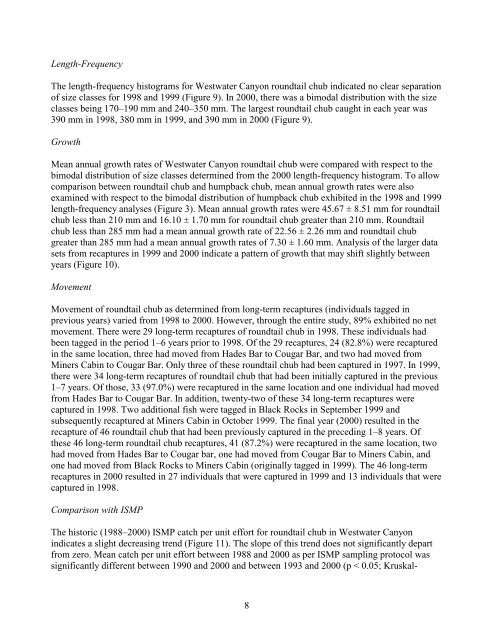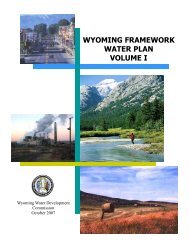population estimates for humpback chub - Upper Colorado River ...
population estimates for humpback chub - Upper Colorado River ...
population estimates for humpback chub - Upper Colorado River ...
You also want an ePaper? Increase the reach of your titles
YUMPU automatically turns print PDFs into web optimized ePapers that Google loves.
Length-Frequency<br />
The length-frequency histograms <strong>for</strong> Westwater Canyon roundtail <strong>chub</strong> indicated no clear separation<br />
of size classes <strong>for</strong> 1998 and 1999 (Figure 9). In 2000, there was a bimodal distribution with the size<br />
classes being 170–190 mm and 240–350 mm. The largest roundtail <strong>chub</strong> caught in each year was<br />
390 mm in 1998, 380 mm in 1999, and 390 mm in 2000 (Figure 9).<br />
Growth<br />
Mean annual growth rates of Westwater Canyon roundtail <strong>chub</strong> were compared with respect to the<br />
bimodal distribution of size classes determined from the 2000 length-frequency histogram. To allow<br />
comparison between roundtail <strong>chub</strong> and <strong>humpback</strong> <strong>chub</strong>, mean annual growth rates were also<br />
examined with respect to the bimodal distribution of <strong>humpback</strong> <strong>chub</strong> exhibited in the 1998 and 1999<br />
length-frequency analyses (Figure 3). Mean annual growth rates were 45.67 ± 8.51 mm <strong>for</strong> roundtail<br />
<strong>chub</strong> less than 210 mm and 16.10 ± 1.70 mm <strong>for</strong> roundtail <strong>chub</strong> greater than 210 mm. Roundtail<br />
<strong>chub</strong> less than 285 mm had a mean annual growth rate of 22.56 ± 2.26 mm and roundtail <strong>chub</strong><br />
greater than 285 mm had a mean annual growth rates of 7.30 ± 1.60 mm. Analysis of the larger data<br />
sets from recaptures in 1999 and 2000 indicate a pattern of growth that may shift slightly between<br />
years (Figure 10).<br />
Movement<br />
Movement of roundtail <strong>chub</strong> as determined from long-term recaptures (individuals tagged in<br />
previous years) varied from 1998 to 2000. However, through the entire study, 89% exhibited no net<br />
movement. There were 29 long-term recaptures of roundtail <strong>chub</strong> in 1998. These individuals had<br />
been tagged in the period 1–6 years prior to 1998. Of the 29 recaptures, 24 (82.8%) were recaptured<br />
in the same location, three had moved from Hades Bar to Cougar Bar, and two had moved from<br />
Miners Cabin to Cougar Bar. Only three of these roundtail <strong>chub</strong> had been captured in 1997. In 1999,<br />
there were 34 long-term recaptures of roundtail <strong>chub</strong> that had been initially captured in the previous<br />
1–7 years. Of those, 33 (97.0%) were recaptured in the same location and one individual had moved<br />
from Hades Bar to Cougar Bar. In addition, twenty-two of these 34 long-term recaptures were<br />
captured in 1998. Two additional fish were tagged in Black Rocks in September 1999 and<br />
subsequently recaptured at Miners Cabin in October 1999. The final year (2000) resulted in the<br />
recapture of 46 roundtail <strong>chub</strong> that had been previously captured in the preceding 1–8 years. Of<br />
these 46 long-term roundtail <strong>chub</strong> recaptures, 41 (87.2%) were recaptured in the same location, two<br />
had moved from Hades Bar to Cougar bar, one had moved from Cougar Bar to Miners Cabin, and<br />
one had moved from Black Rocks to Miners Cabin (originally tagged in 1999). The 46 long-term<br />
recaptures in 2000 resulted in 27 individuals that were captured in 1999 and 13 individuals that were<br />
captured in 1998.<br />
Comparison with ISMP<br />
The historic (1988–2000) ISMP catch per unit ef<strong>for</strong>t <strong>for</strong> roundtail <strong>chub</strong> in Westwater Canyon<br />
indicates a slight decreasing trend (Figure 11). The slope of this trend does not significantly depart<br />
from zero. Mean catch per unit ef<strong>for</strong>t between 1988 and 2000 as per ISMP sampling protocol was<br />
significantly different between 1990 and 2000 and between 1993 and 2000 (p < 0.05; Kruskal-<br />
8
















